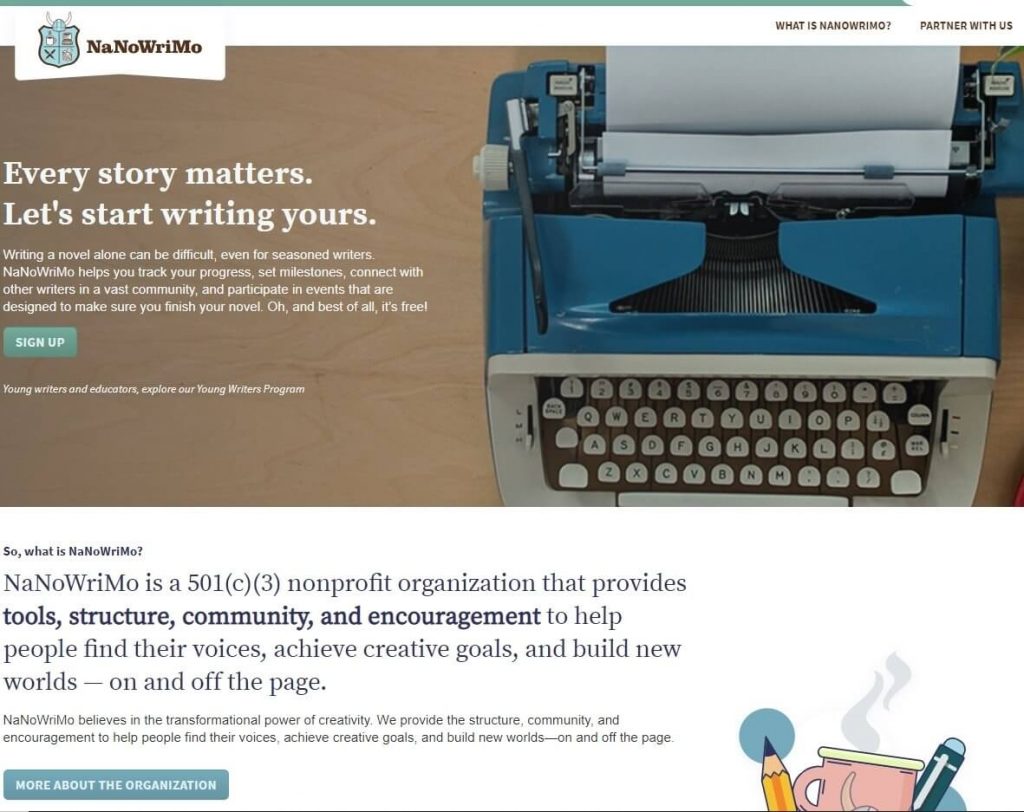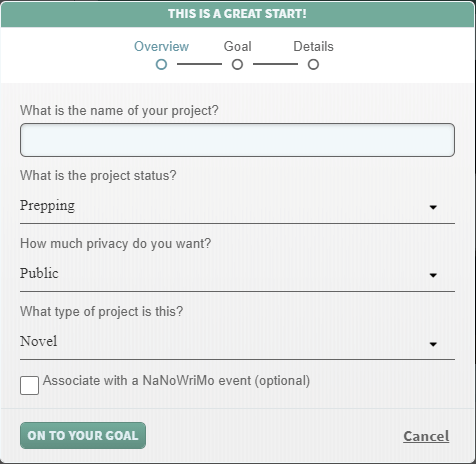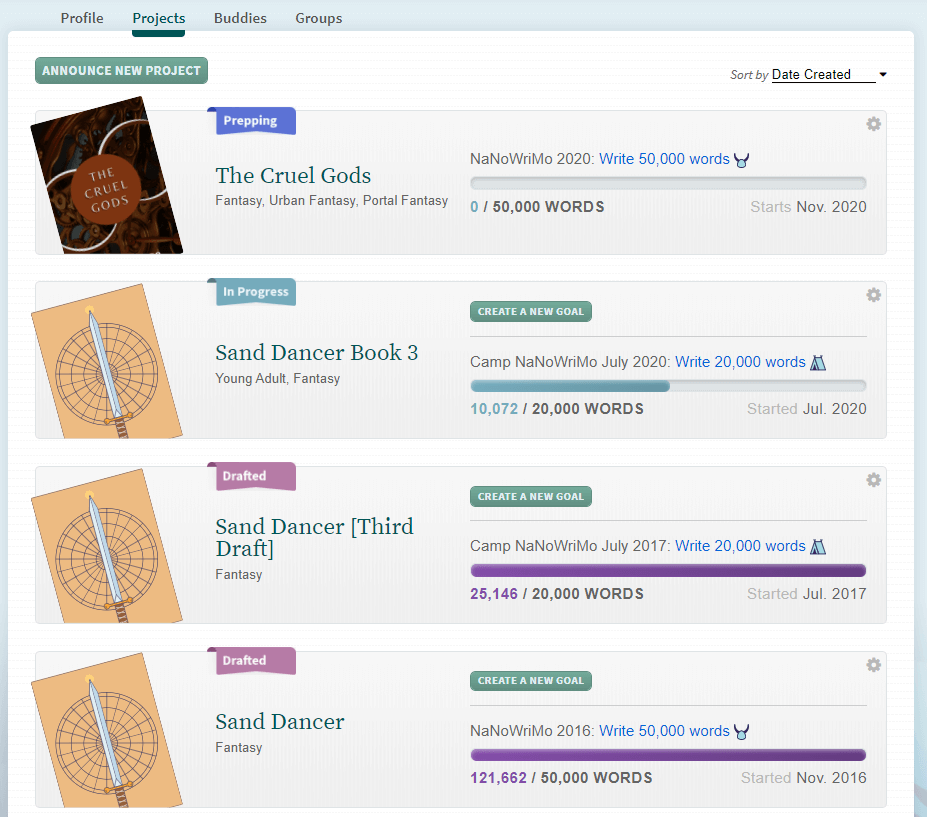We’re only weeks away from November which can only mean one thing; NaNoWriMo is upon is!
For the innocent, NaNoWriMo stands for National Novel Writing Month which takes place every November. The goal is to write an entire novel in a month. Or, more realistically, to write 50,000 words in that month. Sounds tough, doesn’t it? NaNoWriMo certainly isn’t for everyone, but I see it as a boot camp for writers; a way to toughen up, get your ass at your desk, and start that book you’ve always dreamed of.
I’ve “won” NaNoWriMo twice now with various drafts of Sand Dancer. In fact, the very first draft of my published novel was written during NaNoWriMo 2012 and then re-written again in November 2016. I can attest that NaNoWriMo is a fantastic tool for working on your novel. Not just because you’ll be aiming for that word goal, but also because the NaNoWriMo community itself is incredibly supportive for new and experienced writers alike.
Writing 50,000 words in a month is tough. But I’m here to help you achieve it. So here’s part one of two guides on how to prepare for NaNoWriMo… and survive it!
October is known as “Preptober” as the more responsible writers amongst us plan their book. Not everyone can or will outline, and some people will be entering November with the faintest of ideas and just go running downhill from there. Whether you’ll be diving in the deep end or planning your novel with meticulous detail, there are a few things you’ll need to do before you’re ready for NaNoWriMo.
Join the NaNoWriMo Website
First step, you’ll want to join the official NaNoWriMo website over at www.nanowrimo.org!
There’s a few reasons why I’d recommend joining the official website. For one, it’s these lovely people who run NaNoWriMo every year. They’ve built up a community of writers across the world and their website also has a ton of resources for the aspiring author, including motivational pep-talks from well loved authors. The NaNoWriMo community includes a bustling message board and you can also join or make groups for your own community or group of friends to support each other. If you’re a new writer who’s dipping their toes into writing for the first time, I’d really recommend starting here!

The best thing about the NaNoWriMo community however is the regional groups. These are groups based in your local area! Pre-pandemic days, these regional groups were a great way to meet local writers and get together for write-ins and to suffer NaNoWriMo together. Now, there’s still scope for virtual write-ins and other community activities. If you’re looking to get involved with the writing scene in your town/city, then I’d recommend finding and joining your regional group. If your region doesn’t have one, ask about starting one!
The official NaNoWriMo Twitter also runs writing sprints during November, so give them a follow, or you can find a number of different writing communities to join. Writing can be a lonely experience, so find a community that works for you.
Of course, one great reason to sign up with the NaNoWriMo website and reach your goal is for the goodies you can win afterward! Not only will you have the satisfaction of meeting your goal by 30th November, but winners who verify their progress will get access to exclusive discounts for writing software such as Scrivener. Worth it!
Set Up Your Project
When you register on the NaNoWriMo website you’ll need to set up a project.
Your project won’t be set in stone, so don’t worry about the fine details; it doesn’t need a title, or a blurb, or a book cover, or any of that – if you’re unsure of the details, just go with a placeholder title and set it up. You’ll need something in order to track your progress each day as the project page allows you to track your daily word count until you reach that magic number of 50,000.

From your project dashboard, just click on “Announce New Project” at the top and fill in what details you want in the pop-up. For a new project, you can throw in any name (My Fantasy WIP, for instance) and then select “Prepping” as your project status. You can choose whether you want to keep your project private or let others see your progress, and you can choose what type of project you’re working on – it doesn’t have to be a novel! That’s the joy of NaNoWriMo; you can use November to write whatever you want!
The goal for NaNoWriMo 2020 will default to 50,000. On the details page, you can add your genre or a summary of the project. You can even link a Pinterest moodboard or Spotify playlist of inspiration if you want, but all of these are optional and can be edited in later.
On your project page, you’ll be able to track your daily progress once November 1st rolls round. I personally LOVE the word count tracker as it not only tallies up and keeps a record of your word count, but it also shows your progress compared to your friends and communities, shows how many words you’ll need to stay on track, and I find it motivates me to keep my writing streak going.
If you’d prefer to track your own word count separately however, I did make my own spreadsheet tracker you might find handy!
So here’s some of my projects and progress over the years – though not all the failed attempts are listed here:

What’s that top one? Oh, only my new secret project! Shhh!
Preparing Your Story
So you’ve joined the website, joined your regional group, and had a nosy around… what now?
Depending on what kind of writer you are, it’s time to either panic/mentally prepare yourself/catch up on your TBR pile, or begin planning out your story. Not everyone likes to outline, but creating an outline before November begins can help you decide what kind of story you want to write. The biggest hurdle to writing is the infamous writer’s block, and I believe this is caused by not knowing what to write or where your story is going.
To hit your goal of 50,000 words by the end of November, you need to write roughly 1666 words a day.
Does that sound like too many words? Are you hyperventilating already? For many of us mere mortals, 1000 words a day is a lot! Many of us will be juggling a day job or a family life which will leave very little time to write 500 words, let alone 1666 of them. On average, it takes just under two hours to write 2000 words, so at 1666 a day, it’ll probably take about an hour and half, but the amount of time it’ll take YOU to write that many words depends on many factors, including how busy you are, how easily distracted you’ll be, and how much you’ll need to think and plan out your story. Thinking and planning is part of the writing process so don’t forget to factor in time for those when you plan your writing schedule.
But the easiest way to cut down on the thinking and planning part is to plan your story before you start writing it, thus freeing up your precious brain for the act of writing.
If you’ve never outlined a story before, then fear not! There are many different methods and guides on how to create a basic outline. Here are a few that I recommend:
- The Three Act Structure: Split your story into three acts. Most stories naturally fall into a structure of a beginning, middle, and end, but this structure goes in more depth.
- The Hero’s Journey: A structure for organising your story into an epic and heroic journey. Perfect for fantasy, and used by many well known films/franchises such as Star Wars and Harry Potter.
- Save the Cat: A screenwriter’s method of breaking your story into beats or scenes. Excellent for planning any novel!
If the thought of making a detailed outline makes you want to run for the hills, then don’t panic. Even just a very basic outline could help you. I use the Three Act Structure, but instead of writing a detailed outline, I mostly just use bullet points and create a list of what happens in order. And then for each chapter I write, I write a little list of what will happen in that chapter – how it begins, what happens, what the conflict/trouble is the hero needs to overcome, and how it ends. It doesn’t always have to be a good end!
Outlining your story is just one part of planning a book of course. You’ll also need to think about the setting for your story and your characters.
For the setting, I’d go with a basic description for now, enough that you could describe the scene your characters are in. There is a temptation to spend weeks creating a whole world for your story, especially if you’re writing fantasy, but be careful you don’t fall down a rabbit hole. The first draft of any book doesn’t need to feature detailed descriptions of your setting. That’s all things you can flesh out later!
Instead, spend a bit more time getting to know your main character and any other character important to the story, such as the sidekick and antagonist. You’re going to be spending the next month stuck in these character’s heads, so it will pay now to understand your character and avoid getting stuck in a few weeks time because you’re not sure how they should act.
Forget learning their favourite colour or blood type, here’s some questions you can ask yourself:
- Who is your character? Their gender, age, job, and experience?
- What do they want? What is the motivation that propels them to act in your story?
- What is their external goal? What are they trying to achieve?
- What is their innermost goal, desire, or fear?
- How does the antagonist conflict with the main character? How are they stopping the main character from achieving what they want?
- And how will the main character oppose the antagonist and stop them from getting what they want?
A well-rounded character has agency. They drive the story through their actions and they act because they want or need something.
Remember, your story will be a new draft. A new baby book. You’ll be discovering it and exploring it as you go along, so don’t worry if your story deviates from its outline or you think of a better direction as you write it. That’s all part of writing. For the first draft, and especially for NaNoWriMo, it doesn’t matter if your story ends up a incoherent mess at the end. Don’t sweat it, and don’t be tempted to go back and re-write or edit either, but these are lessons we’ll cover in part two of our NaNoWriMo guide; how to survive!
Organise Your Writing Space
So you’ve now got the bare bones of your story down and you’re ready to begin! Or are you?
As mentioned above, your commitment to NaNoWriMo means you’ll need to write at least 1666 words a day to meet your goal. Logistically, you’ll need to set aside some time to fit your writing in – a couple of hours at least every day. Or, you can put together larger chunks of time on your days of/weekend to catch up on what you miss. You’ll also need to think about where you’ll be writing. Only you know how you work best, whether in complete silence or with people around you, whether at dawn or dusk. Some people need their own personal office whereas others need to be sat at their local coffee shop.
Depending on how you work best, I’d recommend making a dedicated writing space and allocating a time slot just for the purpose of writing. Let your family and friends know not to disturb you at this time and grab the things you’ll need to work at your best. If you get easily distracted and know this is a problem, you may want some headphones and find a decent writing playlist on Spotify. Listening to ambient sounds or white noise may help.
If you’re not sure when or how you work best, then this November will be a great time for you to experiment and find out. Remember, there is no best way to write! Writing is an entirely personal experience. If you work best using your laptop on the top of a snowy mountain, then great, it doesn’t matter if it’s weird to everyone else, as long as it works for YOU!
Unfortunately, with the current pandemic, writing at your local coffee shop may not be viable, but there are virtual alternatives! There are many videos on YouTube (like the one below) that can recreate the ambience of a coffee shop. And if you need the real thing, I’d recommend stocking up on your favourite brew before November arrives.
Pick Your Writing Tools
So you’re all set to start NaNoWriMo… But HOW do you plan to write?
Don’t worry, it’s not a trick question! I just want to make sure you have your software lined up. Writing can be an inexpensive hobby; you don’t need a fancy typewriter or laptop to be a writer. Nor do you need to pay for software like Scrivener or Microsoft Word unless you want to. If you already have a decent word processor, then great That’s all you need to start writing.
If you don’t have a word processor, then here are some free alternatives to word you can use:
- Open Office: A free alternative to Word which comes with its own writing software for Windows and Mac.
- Libre Office: A free alternative to Word which comes with its own writing software for Windows and Mac.
- Google Docs: Google’s free online word processor which is simple to use and comes with an auto-save, but you need to be online to use it.
- Focus Writer: A distraction-free writing environment for Windows and Mac.
- Calmly Writer: Another distraction-free writing environment but it also has support for writers with dyslexia.
And that’s it! You literally don’t need anything else. But in part two of this guide I’ll share some more writing tools and resources you might find helpful, or you can take a look at my handy list of tools.
And that’s my guide on how to prepare for NaNoWriMo… Come back on the 1st November for my guide on how to start NaNoWriMo and survive it!
Will you be taking part in NaNoWriMo this year? I’ll be attempting it with my new super secret project!




